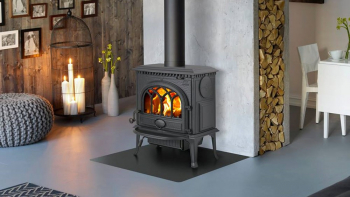Unveiling the EPA’s New Emission Standards
The Environmental Protection Agency (EPA) instituted new emission standards for residential wood heaters, including wood stoves, pellet stoves, hydronic heaters, and forced air furnaces, becoming effective in stages. These guidelines are meant to curb the negative environmental impacts linked to residential wood smoke.
The Two-Step Implementation:
-
-
- Step 1 (Implemented on May 15, 2015): Limited emissions to 4.5g/hr of particulate matter.
- Step 2 (Became effective on May 15, 2020): A more stringent limit of 2.0g/hr of particulate matter was enforced.
-
While these regulations are not yet applicable in Ontario, the vast North American market, predominantly led by the USA, implies that many manufacturers design their products to comply with these standards.
Understanding Particulate Matter in Wood Smoke
Particulate matter (PM) encompasses airborne particles present in both solid and liquid forms. These tiny entities, capable of being carried by air, might find their way into your lungs, posing significant health risks. To give you a perspective, PM can be as minuscule as 0.005 microns, while a human hair has an average diameter of 60 microns.
The Importance of Regulating Residential Wood Smoke
Residential wood smoke, laden with fine particles and toxic air pollutants, can escalate health concerns like bronchitis, respiratory problems, and even premature death. It is a concoction of harmful elements, including volatile organic compounds (VOC), carbon monoxide (CO), and other toxic air pollutants like benzene and formaldehyde. These substances are notorious for causing burning eyes, runny nose, and aggravating heart and respiratory issues, especially in children, older adults, and individuals with preexisting health conditions.
Products Under the Scanner
The EPA’s new emission standards predominantly target:
-
-
- Wood Stoves
- Pellet Stoves
- Wood Heaters
- Forced Air Furnaces
- Hydronic Heaters
-
Not affected are:
-
-
- Outdoor Fireplaces
- Pizza Ovens
- Barbecues
- Chimineas
- New/Existing heaters fueled solely by oil, gas, or coal
-
A Guide for Responsible Wood Stove/Heater Operators
As a wood stove or heater operator, adhering to the new guidelines is crucial. The standards prescribe specific types of fuel permitted for residential use, banning the burning of waste petroleum products, garbage, yard waste, and several other materials.
To remain compliant and ensure the safety and health of your community, always follow the instructions outlined in the owner’s manual of your equipment. Remember, transitioning to cleaner heating alternatives not only conserves the environment but also contributes to a healthier and happier community.





